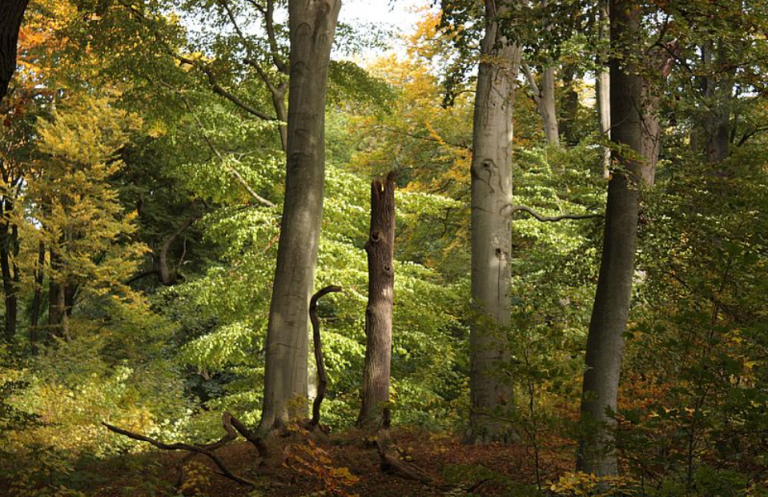Dry Summers Like 2018 Were Common in the Middle Ages
As part of the current collaborative research project BaltRap (The Baltic Sea and its Southern Lowlands: Proxy-Environment interactions in times of rapid changes), the researchers investigated growth rings in nearly 2000 living beech trees – including some from the university’s own Elisenhain forest – and archaeological wood used for construction from around 1000 A.D. The growth rings found in this wood are a unique archive of previous environmental conditions. If the climatic conditions are good, growth rings are wide; in unfavourable years, like in dry 2018, there is little growth. Dendroclimatology uses this correlation to reconstruct past environmental conditions.
Industry fertilizing trees
Trees now grow much faster than in the past. One reason for this is the increased use of nitrogen in agriculture, the industrial sector and various means of transport. This then infiltrates the forests through the air and rain. This nitrogen fertilisation, also known as eutrophication, leads to much higher rates of growth in our forests, which traditionally have limited amounts of nitrogen.
CO2 fertilizing trees
Higher levels of CO2 in the air also encourage growth. Nowadays, trees can absorb the same amount of carbon whilst opening their stomata for much shorter periods, thus losing less water due to evaporation. Both of these factors lead – as long as there is enough water – to more forest growth.
“We aren’t the first scientists to confirm this trend,” says Dr. Tobias Scharnweber, one of the authors of the article. “However, what is new in our reconstruction is that we were able to calculate these growth rates using our own data method that we had developed especially for this project. This enabled us to show that average summer rainfall amounts were much lower at the time of the Mediaeval Climate Optimum, i.e. approximately 1000 years ago, than previously presumed. Maybe ‘one-in-a-century’ summers, like the one we had in 2018, were not that rare back then.”
Results like these help to make the fluctuations in today’s climate change that is caused by human activity seem more natural from a long-term perspective. By using their new methods, the scientists from Greifswald have shown how important it is to statistically consider the growth conditions of today, which are considerably different to those of the pre-industrial period, when producing climate reconstructions based on growth rings. Further
Information
Research Group Landscape Ecology and Ecosystem Dynamics
www.nature.com/articles/s41598-019-39040-5
Media Photos
Contact at the University of Greifswald
Prof. Dr. Martin Wilmking
Institute of Botany and Landscape Ecology
Research Group Landscape Ecology and Ecosystem Dynamics
Soldmannstraße 15, 17489 Greifswald
Tel.: +49 3834 420 4095
wilmking@uni-greifswald .de
Dr. Tobias Scharnweber
Tel.: +49 3834 420 4188
tobias.scharnweber@uni-greifswald .de






I don’t see why this would surprise anyone … it was almost as warm as today, but for a considerably longer timespan.
[…] by P. Gosselin, June 19, 2019 in NoTricksZone […]
Yes it certainly was hotter in the past.
However looking at WEATHER for the coming 10 days, all of Europe should be impressively HOT as a plume of hot air pushes up from Africa.
As shown here, https://youtu.be/6Ugh1BNQOXc most weather models are predicting very hot temperatures for a while (till the end of the month). There may also be some impressive local convective effects causing some local hail and thunder storms by the month’s end.
[There’s one caveat however — NONE of the weather models forecasts (of more than 5 days) have been particularly accurate this year as they struggle to come to terms with effects of a solar minimum and the current oceanic effect.]
So look out everyone as the cAGW advocates will doubtless grab onto this weather effect to propagandize it as a sign of ‘catastrophic global warming’ and not see it as it is, just some local natural weather variation.
Well, that depends on you definition of “the past” and how localized your view on temperatures is.
For global temperatures in the past millenia that’s definitly not true.
Well, one extrem event doesn’t make a pattern. But we’ve seen plenty such heat waves in the last decades now.
There exists a fun visualization of the global and local warming:
https://www.climate-lab-book.ac.uk/2018/warming-stripes/
So yeah, there were warm years before. But even you can’t ignore the trend, can you?
Read and learn https://notrickszone.com/2019/06/17/consensus-200-new-2019-papers-support-a-skeptical-position-on-climate-alarmism/#comment-1301071
[…] https://notrickszone.com/2019/06/19/dry-hot-north-german-summers-were-more-common-1000-years-ago-sci… […]
[…] https://notrickszone.com/2019/06/19/dry-hot-north-german-summers-were-more-common-1000-years-ago-sci… […]
[…] https://notrickszone.com/2019/06/19/dry-hot-north-german-summers-were-more-common-1000-years-ago-sci… […]
[…] Dry Hot North German Summers Were More Common 1000 Years Ago, Scientists Report […]